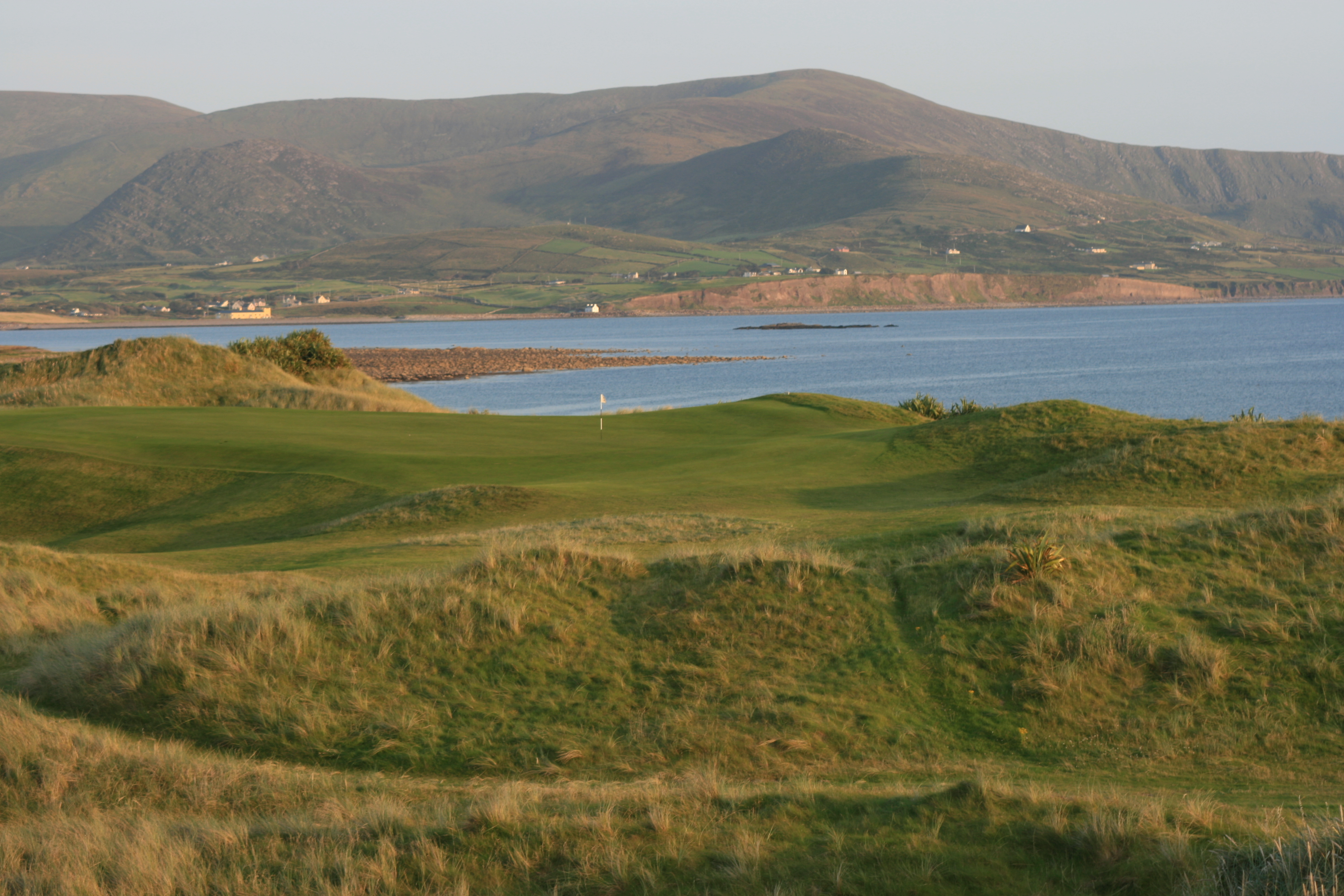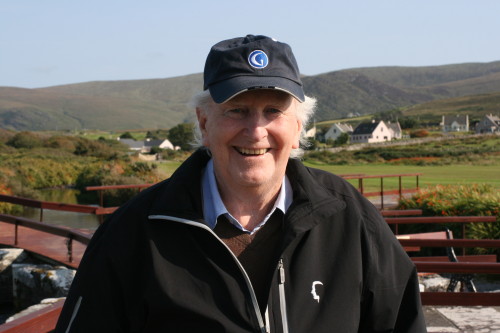Ireland, day four: Waterville, a new favorite course (updated)
A tough, but fair, test of golf.
WATERVILLE, CO. KERRY, Ireland — In the mid-1980s, an American named Jay Connolly, along with several club members from Winged Foot Golf Club in New York, came to southwest Ireland, played Waterville Golf Links near the peaceful village on the Atlantic Ocean and fell in love with the place.
By then, Connolly was a decorated veteran of the Vietnam War, a helicopter pilot who’d earned a Distinguished Flying Cross for bravery in battle, providing cover for a group of pinned-down U.S. Marines. “If you’re a helicopter pilot, you don’t look for medals, they find you,” said Connolly, now 72. When he left the service, he never piloted again. “I’d used up all my luck,” he said.
Jay Connolly is a partner in Waterville Golf Links in Ireland.
He went to work “on the Street,” meaning Wall Street, for the investment banking firm of Salomon Brothers, rising to partner, making his fortune, playing golf at special places along the way (he’d played in college), and that brought him to Ireland, where in 1987 or so he and some other Winged Foot members purchased Waterville from John Mulcahy, the Irish-American who had built the modern version of a course where golf had been played since the 1880s.
And now it is simply one of the best courses in the world, an international draw, but one that is favored by locals, a quietly beautiful and subtly challenging course. You might come a long way to play Ballybunion once, or Tralee once; you could see yourself playing Waterville over and over again, a long relationship. It doesn’t have waves crashing below, but wonderful views of the River Inny estuary and Ballinskelligs Bay and the tallest mountains in Ireland.
Saturday, Connolly drove out in a cart to welcome us as we played the fourth hole at Waterville; afterward, he sat with us during lunch, and then took us to Waterville House, a 12-bedroom in, dating to 1790, where international members of the club and other visitors stay, and where each room is named for a famous golf course designer (Old Tom Morris, C.B. Macdonald), and where there is a stream for fly-fishing, and a little practice range.
The course, Connolly said, is “very fair but very difficult;” there’s not a lot of trickery or blind shots, but it’s sobering when you realize that on a par-72 course, the competitive course record is merely 71, and that by Tony Jacklin, the year after he won the U.S. Open.
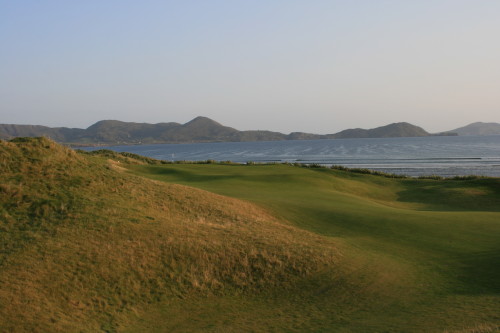
The 16th green at Waterville Golf Links, a hole known as Liam’s Ace.
According to the book “True Links”, “it was the men who worked on the transatlantic cable relaying messages between North America and Europe who introduced golf to the wild linksland of Waterville. Back then, in the 1880s, it was a crude form of the game played in the winter months, when the grass went dormant.” By the 1950s the course had fallen into disrepair, and the course was dormant for a decade before John Mulcahy sought to build a world-class links course on the site.”
Eddie Hackett, the legendary and prolific designer of courses in Ireland, designed the course, with former Masters champion Claude Harmon, Butch’s father, and it opened in 1973. And so Mulcahy is the true founder of the place, the person who put it on the map; his ashes are buried under a monument at the back tee of No. 17, the highest point of the course, Mulcahy’s Peak.
In 2002, Connolly’s group retained Tom Fazio to update the course, which was “a little bit tired” by then — a runner-up for the job was Tom Doak, designer of Pacific Dunes at Bandon Dunes Golf Resort, and Doak had great ideas, Connolly said, and that was a tough phone call.
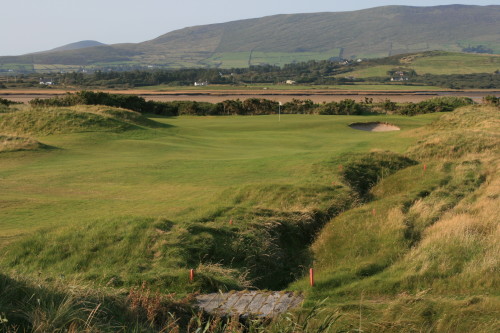
The No. 6 hole at Waterville Golf Links, framed by the River Inny Estuary.
Fazio added new par-3 sixth and par-4 seventh holes and altered 13 others, adding new tees and greens, putting more undulation in some greens and building up the dunes in a way that holes became their own world. It was a four-year project, Connolly said, and the result is a golf course that stands with Lahinch, Tralee, etc., as courses on a must-play list if you’re making a trip to Ireland.
“We’re all part of a family,” Connolly said. “All the courses work together as a magnet.” And, make no mistake, “Americans are the driving force, big-time,” in the prosperity of Ireland’s golf industry. (Though Connolly recommended that visiting golfers treat their Ireland excursion as “a 10,000 meters run,” rather than a sprint, taking time to play a course twice, for example, rather than dashing off to the next.)
Waterville is a popular site for golfer preparing for the British Open, most notably Mark O’Meara, the year he won; the late Payne Stewart loved the place, and was named captain there shortly before his death, and is memorialized by a statue. The course has hosted Irish Senior Amateur, and Connolly said he wants to do more collegiate events; in October, teams from Notre Dame, Texas A&M and North Carolina-Wilmington are coming over to play teams from three Irish universities — and, Connolly said, don’t underestimate the ability of the Irish golfers to “get the ball in the hole” in late-October weather.
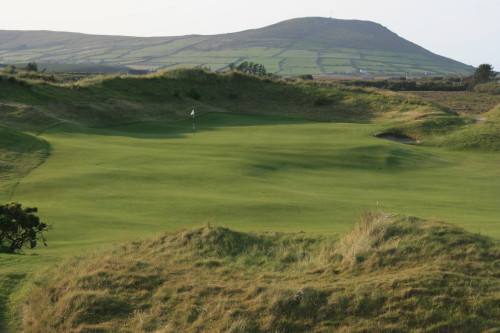
The 15th green at Waterville Golf Links in Ireland.
In his book, “A Course Called Ireland”, Tom Coyne wrote:
“In a country where the holes could look the same — lovely but similar, a regular rhythm of dune, gorse, dune, pub — the holes in Waterville made memories. The second was a bold bully of a par four running down and away from you with an approach shot into a backdrop of estuary waters and Kerry mountains.
“The par-threes were each unforgettable, the most stunning being the Mass Hole, where we hit five-irons over a yawning crater, a deep hollow in the dunes where Catholic mass was held in secret during penal times. Original plans asked for the 12th green to be placed within the hollow, but laborers refused to break the ground where mass had been celebrated. Mr. Hackett was happy to push the green back and upward into the hillside, adding a few yards and a half stroke of difficulty (so if you doubled the Mass Hole, you could vociferously blame it on Jesus Christ without sinning). And the view from the tee box on Mulcahy’s Peak must have been the most popular photo stop in Ireland. The tee sat at the peak of Waterville’s tallest dune, every hole on the course in plain view, ocean rolling up on to the beach behind the green.”
Last year, Golf Digest ranked Waterville No. 93 in the world. Two holes, No. 17, a 196-yard par 3, and No. 11, a 496-yard par 5, are cited in “The 500 World’s Greatest Golf Holes.” The par 3, Mulcahy’s Peak, is the final resting place for Mulcahy. The par 5 seems a natural hole, such as workers might have played back in the 1800s.
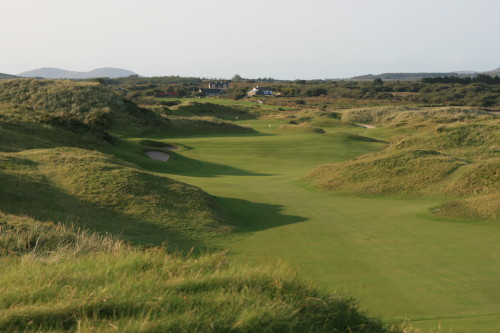
The 11th green at Waterville Golf Links, with the 15th green beyond.
Thanks to the courtesy of Tourism Ireland, represented by Bernard McMullan, I played Waterville on Saturday with three Northwest journalists from the Seattle area — Blaine Newnham, the former sports editor and columnist of the Eugene Register-Guard and the longtime columnist for the Seattle Times and author of “America’s St. Andrews” about U.S. Open site Chambers Bay; Tom Cade, senior director of communications for the Pacific Northwest Golf Association and editor of Pacific Northwest Golfer Magazine, who plays to a 2 handicap, and Rob Perry, of Bellevue, Wash., a professional photographer of all things golf, who plays to a 3.6.
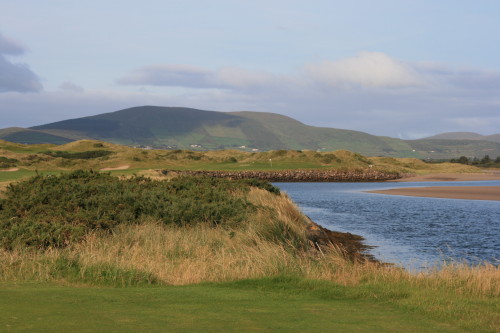
The third hole at Waterville Golf Links, along the River Inny Estuary.
It was a fantastic day, sunny and almost cloudless, and on Saturday morning the course was quiet, just a few golfers out when we started our round about 8:30 a.m. Safe to day, we all fell in love with the place, and not because anyone lit up the scorecard — Perry, though, shot 83 on my card — but because of the beauty of the place, the way the holes drew you in and forced you to think. (The first hole is called “Last Easy,” so be forewarned.)
I loved No. 11, the par 5 that is a narrow valley through the dunes, and the Mass Hole, if only because of the great story. And No. 3, a par 4 along the River Inny; and No. 16, where a club pro once recorded a hole-in-one, and the finishing holes of No. 17 and 18.
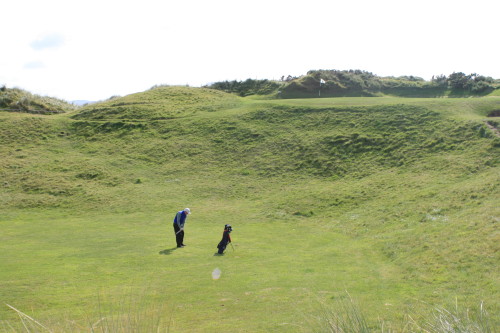
Tom Cade prays for an up-and-down from the hollow of the Mass Hole.
In the daily match between former Register-Guard sports columnists for a pint of Guinness, Newnham won the 18th hole to win the day, after my tee shot found the beach on Ballinskelligs Bay, to go up 3-1 for the trip. It was the third golf ball that I lost on the day, though I found five, which you only do if you’re tramping around in the rough looking for your own ball, so there you have it; for this 19-handicapper, the quest to break 100 in Ireland continues, though I would say that at Waterville, the damage was more self-inflicted than at Tralee, for example, where hitting the ball well (relatively) wasn’t always rewarded. The four-day total: 15 lost, 12 found.
Greens fee for Waterville is 150 Euros (170 on weekends), or about $167.
After our round, and a long visit with Connolly, Perry and I went back to the course for late-afternoon photos; with Cade at the wheel we then drove back to Killarney around the Ring of Kerry, with spectacular views from on high, water below, before returning to our hotel, the Killeen House Hotel, where owners Geraldine and Michael Rosney (who never seem to sleep) run the most hospitable, welcoming place I’ve ever stayed, and where the food is excellent.
Today, Sunday, off to County Cork for a late-afternoon round at Old Head.
(In the October issue of Golf Magazine, Waterville is ranked No. 83 in the world, Lahinch No. 41, and the magazine asked two panelists, architect David McLay Kidd and expert Ran Morrissett, to expound on the differences.
Wrote Kidd: “Lahinch oozes history and individuality. Goats roam the course, and blind shots abound. It’s a perfect example of a great Old World course tailored by Father Time and years of adjustment. The ‘flaws’ — blind, cramped or some overly whimsical holes — have long since been fixed or established as tradition: quirks not to be repeated by now beloved by generations.
“Waterville is still developing its pedigree. … The original nine was laid out over pasture, not dunes, and this is its Achilles heel. In 2006, Tom Fazio undertook a major remodel to address this weakness, doing what he does best: creating a landscape where there was none; in this case, keeping with the dunescape that existed naturally on half the site. A masterful job by a masterful creator.”
Wrote Morrissett: “I rate Lahinch a little higher than Waterville because the land has more random contours and firmer terrain, both of which test your mettle and introduce one or two more maddening events per round. …”)
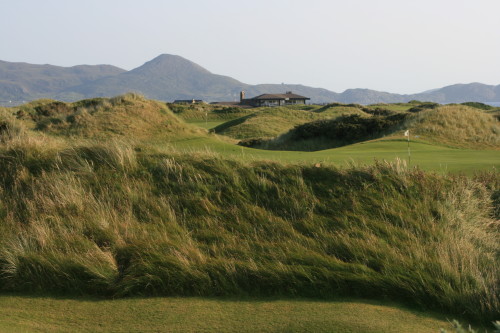
On the front nine, looking back to the clubhouse, at Waterville Golf Links.
